Key takeaways:
- Ligurian focaccia is a beloved cultural treasure known for its golden, crispy crust, soft interior, and notable use of olive oil and fresh herbs like rosemary.
- The history of focaccia spans from ancient times as a nutritious snack for farmers to modern adaptations celebrated worldwide, with regional variations reflecting local ingredients.
- Key techniques for making authentic focaccia include gentle stretch and fold, proper hydration, and allowing for a slow fermentation to enhance flavor and texture.
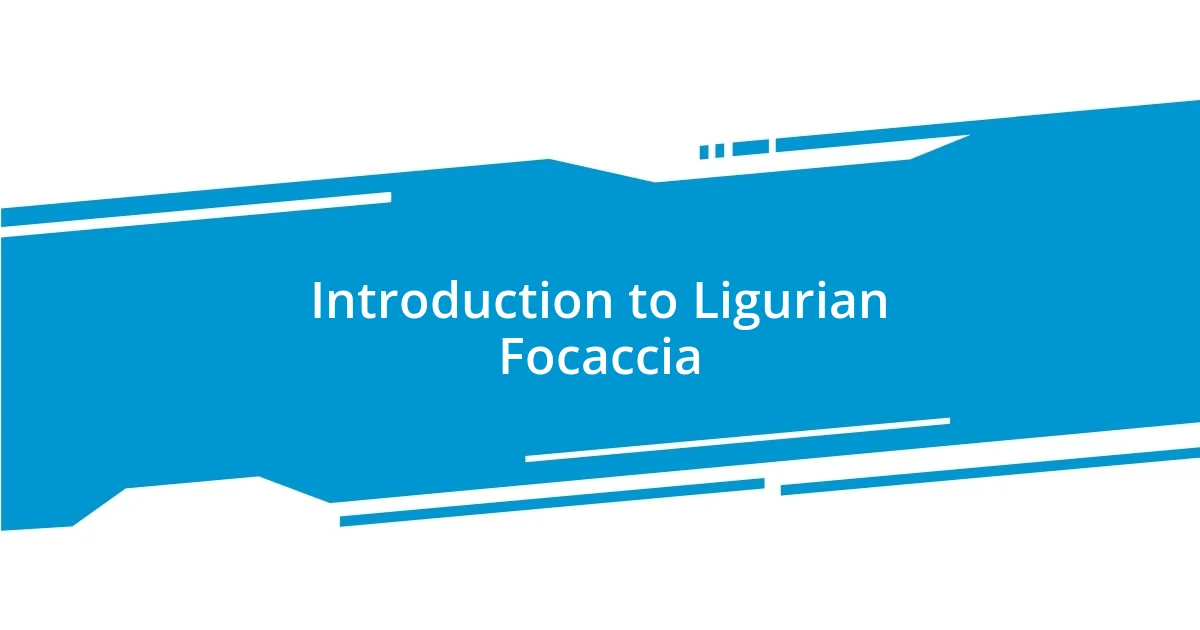
Introduction to Ligurian Focaccia
Ligurian focaccia is not just a bread; it’s a cultural treasure steeped in the sun-kissed landscape of Italy’s northwest coastline. I can still remember the first time I tasted this delightful creation in a small bakery in Genoa. The aroma wafting through the air was so intoxicating that I couldn’t help but be drawn in, and the moment that warm slice touched my tongue, it felt like discovering a piece of heaven.
With its golden, crispy crust and soft, airy interior, Ligurian focaccia has a unique character. Have you ever wondered why it stands out among other bread varieties? For me, it’s that unmistakable touch of olive oil, which not only adds flavor but also enhances the texture, creating a nearly addictive experience. Knowing that you can enhance a simple recipe with such basic ingredients makes it feel approachable yet elevated.
Every region in Italy has its own version of focaccia, but the Ligurian style holds a special place in my heart. It’s the little things, like the gentle flavor of rosemary or a sprinkle of coarse sea salt, that bring this bread to life. Whenever I bake it at home, I can’t help but reminisce about that charming bakery and the joy of sharing warm focaccia with friends over a glass of wine—what could be better?
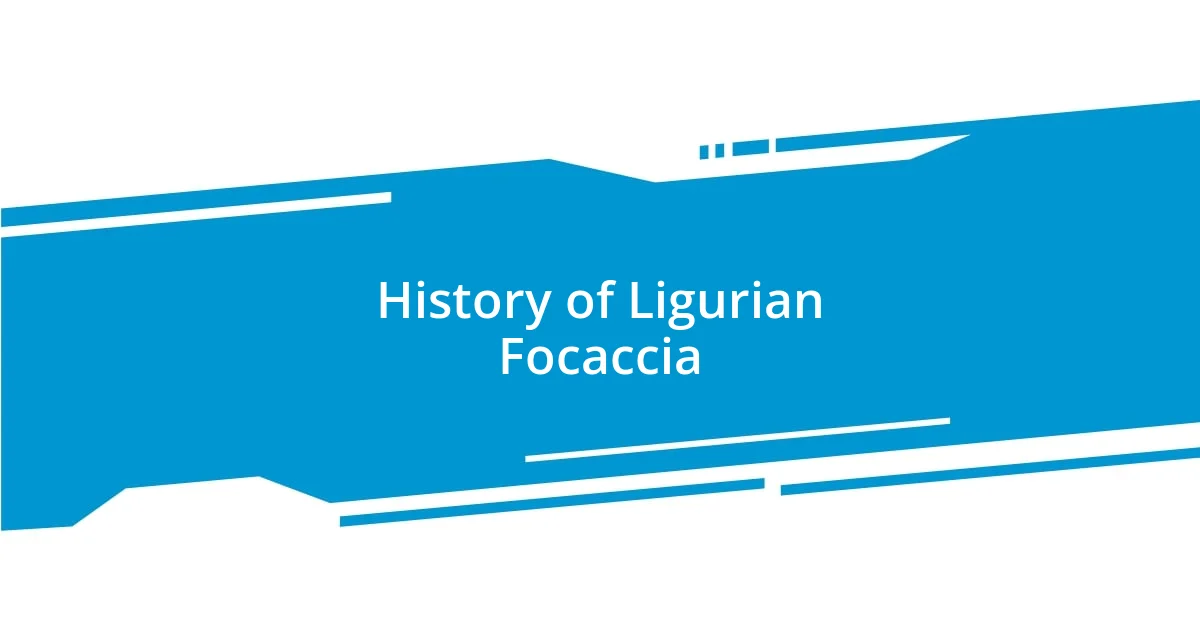
History of Ligurian Focaccia
The history of Ligurian focaccia dates back to ancient times, with roots that intertwine with both Roman and Etruscan cultures. I remember first learning how this bread was once baked on hot stones and enjoyed by farmers in the fields, as a convenient and nutritious snack during long days of hard work. This connection between the bread and its humble origins adds a layer of appreciation for those golden slices fresh out of the oven.
As centuries passed, Ligurian focaccia evolved, finding its place in the culinary traditions of the region. During my travels through Liguria, I discovered that each village seemed to have its own twist, with variations that showcased local ingredients. When I stumbled upon a recipe that incorporated onions, I couldn’t help but jot it down; it was a delightful reminder of the simplicity and beauty of home-cooked meals.
Today, this traditional bread is celebrated worldwide, enjoyed not only in its homeland but also in kitchens far from the shores of Italy. My own attempts at making focaccia have been met with mixed results, but the joy of experimenting with flavors and textures has been immensely rewarding. There’s something incredibly special about sharing a piece of my journey and the stories tied to this amazing bread with friends around a table.
| Time Period | Description |
|---|---|
| Ancient Times | Focaccia was enjoyed by farmers as a simple, nutritious snack baked on hot stones. |
| Medieval Era | Regional variations began to emerge, highlighting local ingredients and traditions. |
| Modern Day | Ligurian focaccia is admired globally, with recipes evolving to include innovative flavors. |
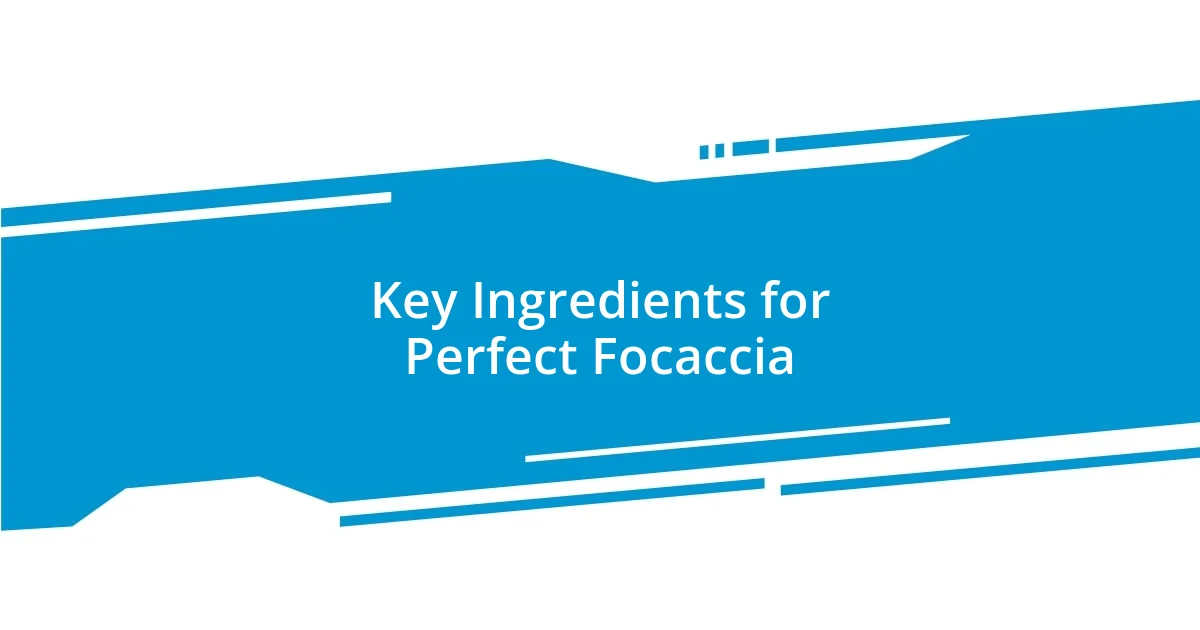
Key Ingredients for Perfect Focaccia
When it comes to crafting the perfect Ligurian focaccia, the choice of ingredients is crucial. I’ve learned that simplicity is key; using high-quality components can elevate this bread to a whole new level. One of the main secrets I’ve found lies in the olive oil—opt for extra virgin for the best flavor and texture. When I drizzled some high-quality olive oil over my dough, the difference was undeniable; it transformed the focaccia from good to mind-blowingly delicious.
Here are the essential ingredients I always ensure to include:
- High-Quality Extra Virgin Olive Oil: For flavor and that signature crust.
- Strong Flour: Bread flour or all-purpose flour for a chewy texture.
- Warm Water: Activates the yeast, which helps create that airy interior.
- Fresh Yeast: Provides the perfect rise and texture; if using dry yeast, adjust accordingly.
- Coarse Sea Salt: Enhances the dough’s flavor and adds a nice crunch on top.
- Fresh Herbs (like Rosemary): A personal touch that infuses the bread with aromatic goodness.
Every time I see the dough bubbling with life, I can’t help but feel a rush of excitement. It’s like waiting for a surprise gift to be unwrapped! The aroma that fills my kitchen as it bakes not only brings back memories of Italian markets but also warms my heart. It’s in those moments, when I share a freshly baked slice with loved ones, that I realize the true magic of focaccia—it’s not just a recipe; it’s an experience.
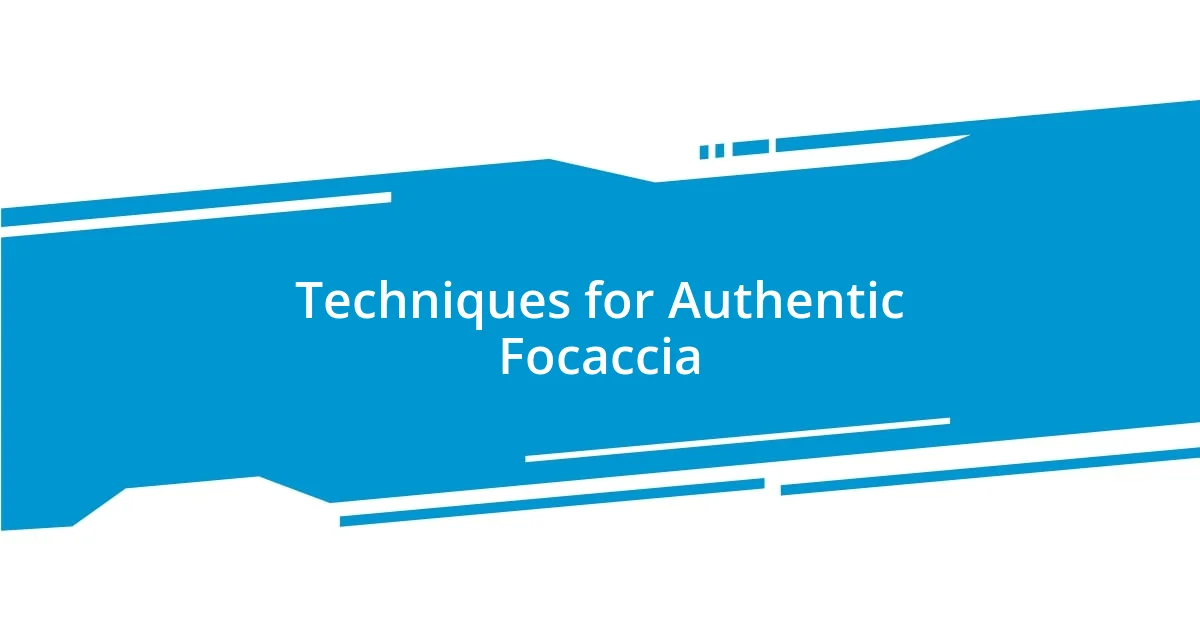
Techniques for Authentic Focaccia
When it comes to making authentically Ligurian focaccia, it’s all about the technique. One method I’ve found particularly effective is the gentle stretch and fold. This approach allows the gluten to develop without harsh kneading, making the dough airy and light. I remember the first time I tried it; the dough felt magical in my hands, and seeing the beautiful bubbles form was a moment of pure joy!
Another key technique involves proper hydration. I’ve discovered that using a higher water-to-flour ratio yields a softer, more tender focaccia. In my early attempts, I was hesitant to add that extra water, but once I did, the resulting bread was remarkably fluffy. Have you ever felt that satisfying squish of a perfectly baked slice? It’s such a rewarding experience!
I also can’t stress enough the importance of patience during the fermentation process. Allowing the dough to rise slowly overnight in the refrigerator not only builds flavor but also improves the texture. The first time I tasted focaccia with that depth of flavor, I realized that good things really do come to those who wait. Trust me, every minute of waiting is worth it when the finally baked loaf comes out—golden brown with delectable, aromatic toppings!
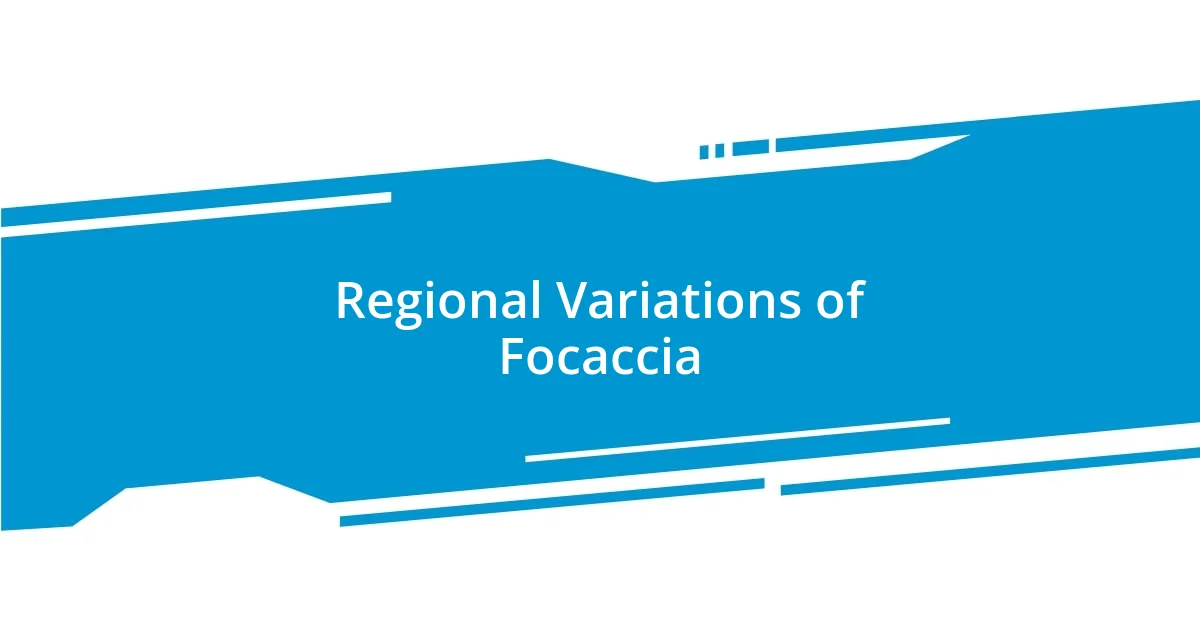
Regional Variations of Focaccia
One of the fascinating aspects of focaccia is how it varies by region in Italy. In Venice, for instance, you’ll find focaccia dolce, a sweet version sprinkled with sugar and often paired with cream. I remember my first bite of this treat; it was like discovering a hidden gem! The balance of sweet and savory opened my eyes to how versatile focaccia can be—who knew it could be a dessert?
Traveling down to Genoa, the birthplace of focaccia, you encounter the traditional focaccia al rosmarino, generously topped with rosemary and coarse sea salt. The first time I made it, the fresh rosemary from my garden made such a difference. Watching the dough rise, infused with that fragrant herb, created an aroma that felt like it wrapped me in a warm, comforting hug. Do you have a herb garden? I highly recommend using fresh ingredients; it truly elevates the dish.
Then there’s the focaccia from Apulia, known as focaccia barese, which boasts a heartier and thicker base topped with tomatoes and olives. When I tasted it during a summer trip, the combination of sun-ripened tomatoes and salty olives was a revelation. It made me think about how local ingredients can transform a dish. Have you ever considered how your region’s flavors could enhance your cooking? That trip inspired me to experiment with my own focaccia, incorporating local produce and making a delicious connection to place.
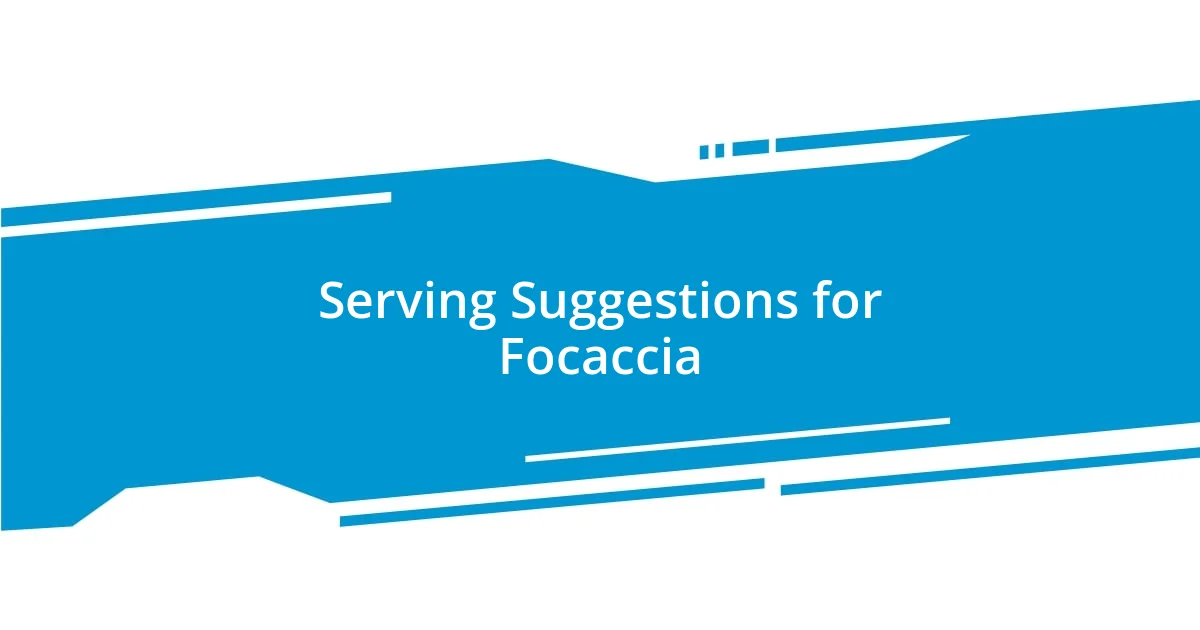
Serving Suggestions for Focaccia
I love serving focaccia in a way that highlights its versatility. One of my favorite methods is to pair it with a variety of dips. Olive oil mixed with balsamic vinegar is a classic choice. The first time I served this at a gathering, my friends couldn’t stop reaching for more. It’s amazing how a simple bowl of oil can elevate the experience. Have you ever thought about how a dip can completely change the vibe of a meal?
Another approach I enjoy is using focaccia as a base for sandwiches. I remember one sunny afternoon, I crafted a turkey and avocado sandwich between two slices of warm focaccia, and it was a game-changer. The texture of the bread added a delightful crunch that contrasted beautifully with the creamy avocado. Have you tried experimenting with fillings? I encourage you to get creative; the options are endless!
For a more casual service, I like to cut focaccia into small squares and serve it as a snack at parties. I once made several batches, each topped with different ingredients—caramelized onions, fresh tomatoes, and even spicy peppers. Watching my guests mix and match their favorites was pure joy. It’s not just about the flavors; it’s about the experience of sharing good food. What toppings would you love to include?
















